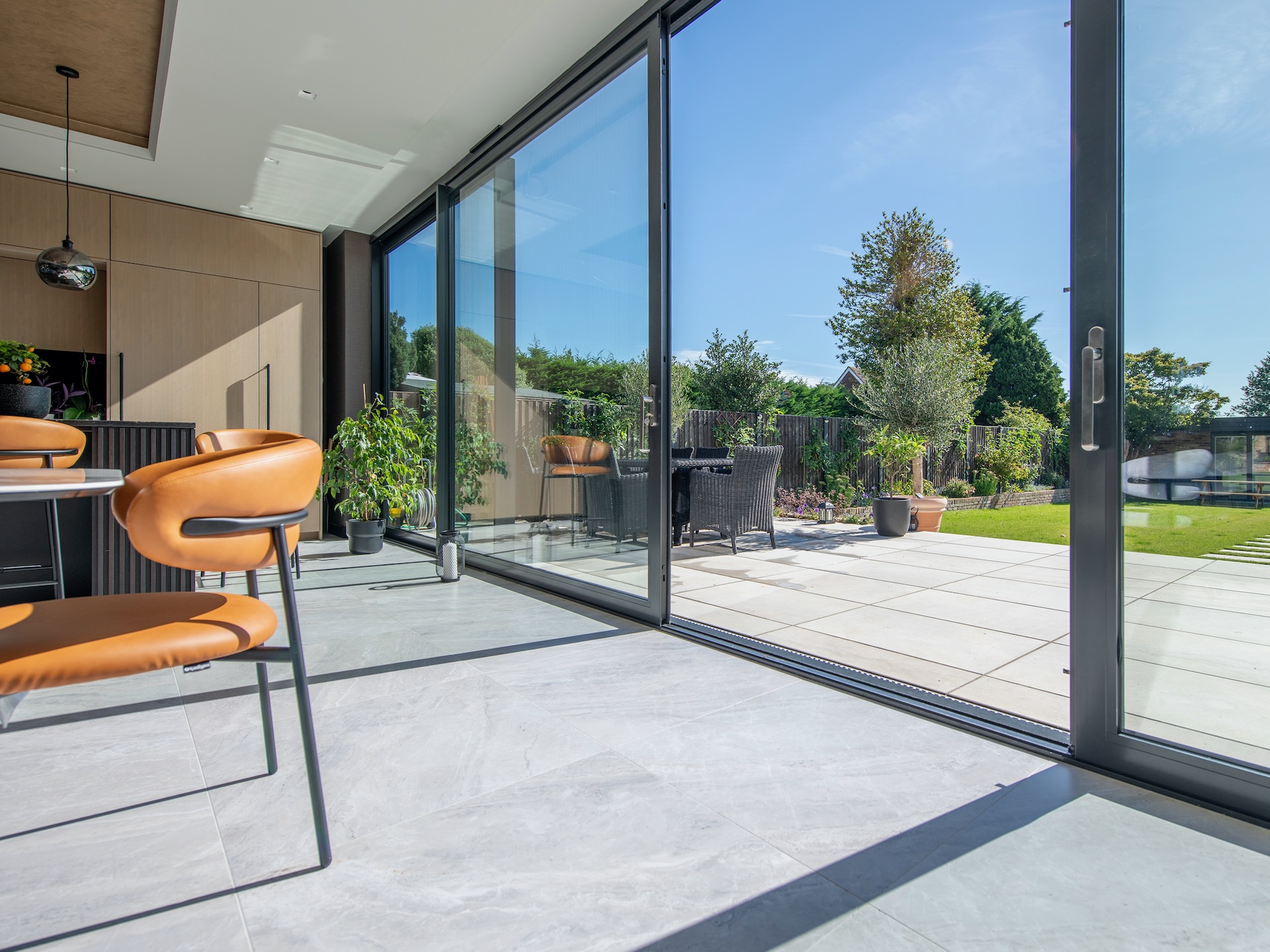
Image credit: Express Bi-Folding Doors
Sliding doors or bi-folds? Which are best for your home
If you’re renovating your current home or designing your dream property, it’s quite likely that sliding doors or bi-folds are high on your wish list. In this comprehensive guide, we’ve enlisted the experts to find out everything you need to know about sliding doors and their bi-fold equivalents. Read on to understand which suits your space best, including size, cost, maintenance, and window dressing.
Sliding vs bi-fold doors: pane size
When it comes to single expanses of glass in the same construction of frame, sliding doors will beat bi-folds, hands down.
“The maximum individual panel size for a bi-fold or sliding door will depend on the manufacturer, as this is largely determined by the door’s ability to load the glazing weight without affecting operation,” says Victoria Brocklesby, chief operating officer at Origin.
“Other factors affecting maximum panel sizes also include its engineering and the frames’s quality and strength.
The maximum individual sash size for Origin’s OB-36+ aluminium bi-fold is 237.6cm(h) x 100cm(w), and the maximum overall aperture width it can be fit into is 6 metres. Whereas the maximum individual panel size for Origin’s OS-29 aluminium sliding door is 252cm(h) x 220cm(w), and the maximum overall aperture width it can be fit into is 12 metres.
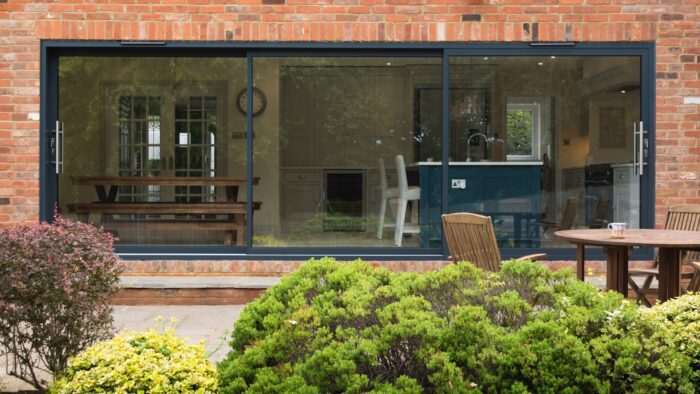
According to Steve Bromberg, managing director of Express Bi-Folding Doors, 7m(w) x 2500mm(h) with three panels is a typical large sliding door install.
“15m wide is probably the maximum size a sliding door series can go to. Individual bi-fold panels can go up to 1500mm wide. You can put a joint in the outer frame, which means that technically bi-fold doors of up to 20 metres are possible, but not common.”
However, it’s always wise to consider the practicality of maxing out on your pane size.
Ryan Schofield, managing director at the Thames Valley Window Company, says, “There is a big trend for large doors with maximum glass, but these are heavy and if they are difficult to operate then they can become a liability and turn off potential buyers when you come to sell.”
Sliding vs bi-fold doors: installation
If you want to install bi-fold or sliding doors into a property that hasn’t had them before, you’ll also need to create an opening (or aperture) for the doors to go into first.
“This isn’t as simple as just creating a hole in the wall,” says Victoria.
“It needs to be precise, and a lintel may be required if it involves removing part of a load-bearing wall.”
However, sliding doors can often be more complex to install due to their size and the wider track needed for the panels to slide and overlap.
“Getting the floor levels right is crucial with sliding doors, so as not to create any trip hazards,” says Steve.
“Sliding doors are assembled on site and often with a four person team to install if the glass is really heavy. Sometimes specialist equipment is needed to lift and the glass. And if the door is structurally bonded, the glass is effectively glued to the frame and then can’t be moved for 24 hours while it sets. Bi-fold doors can arrive built up and be lifted into place. For bigger doors though, and a more thorough installation, they’re usually delivered in parts and then assembled and installed on site.”
Why installation should never be a DIY job
“I would always recommend that a professional installer is selected to fit bi-fold or sliding doors,” says Victoria at Origin.
“It can be a tricky process and you can risk voiding a manufacturer’s guarantee if you attempt to install them yourself.”
It’s also a good idea to ask for a warranty on the installation itself, as Steve will explain later.
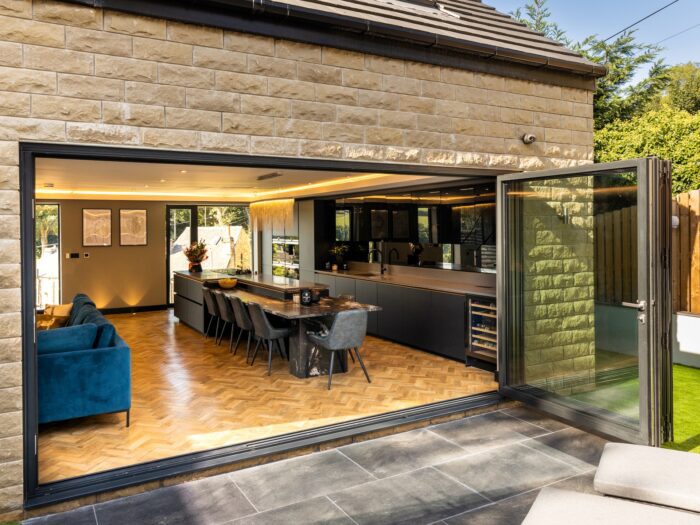
“Replacing and installing doors should only ever be done by a reputable glazing installer,” agrees Ryan.
“Make sure you choose a company that is FENSA registered; a government-authorised scheme that monitors building regulation compliance for the replacement of windows and doors.”
You should also make sure that your installer liaises with your local authority and obtains the right certification for your installation. Otherwise you could land yourself in hot water when you come to sell.
“It is illegal to have glazing installed in a property without a building regulations certificate,” adds Ryan.
Sliding vs bi-fold doors: costs
Both bi-fold and sliding doors have become increasingly popular in recent years and often add value to a home.
“However, make sure you don’t cut any costs or corners and choose a high quality, reliable frame,” Ryan warns.
Bea Szabo, a RIBA chartered architect and advisor for Hii Guru, has specified both bi-fold and sliding doors in her architectural products, and will work with whichever configuration her client prefers.
“However, it will depend on a client’s budget, because a bi-fold door will typically be a bit more expensive than a sliding door,” ,” she admits.
The material chosen will have a big impact on the cost of either style of door, as will the quality of the product.
“Generally speaking, uPVC doors are the cheapest, with wood being the most expensive and aluminium being somewhere in between,” Victoria advises.
“However, fluctuations in material costs over the past couple of years mean that the cost of uPVC is considerably higher than it used to be.”
In reality, though, you might not see too big a difference in cost overall.
“Our three panel bi-folding doors can be installed from around £4,000 inclusive of VAT, and a starting cost for an aluminium door installed would also be around £4,000,” says Steve.
Sliding vs bi-fold doors: maintainance
“The maintenance of your doors will largely depend on the material chosen,” says Victoria.
“Wooden doors will require the most upkeep to ensure the wood doesn’t rot and stays looking great. Those made from uPVC won’t require much maintenance but are weaker than aluminium doors so will wear more quickly over time. Aluminium doors, on the other hand, require little upkeep – in most cases, a quick wipe down with a damp non-abrasive cloth or sponge and a mild detergent will do the trick.”
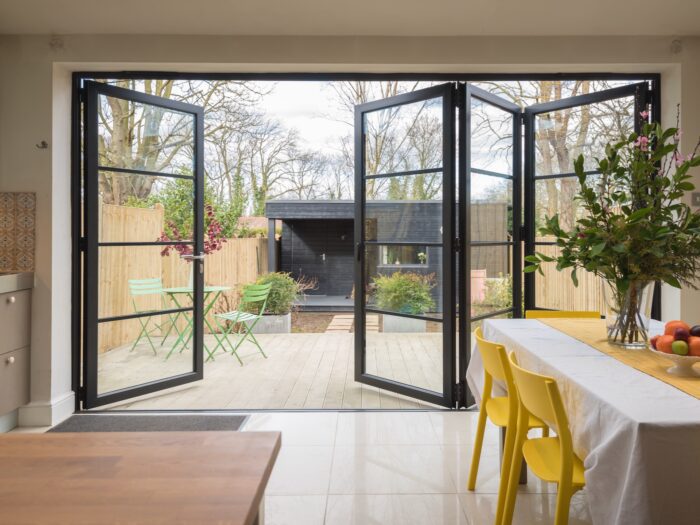
Whichever material you choose, it’s important to keep up a regular cleaning cycle.
“To ensure your doors stand the test of time, a deep clean every six months is advisable for all materials,” says Ryan.
“It’s important to remove bird droppings immediately as the uric acid in the droppings can cause permanent damage to wooden frames and potentially discolour aluminium if left for long periods of time.”
You should clean any debris from the exterior and interior, especially from the track area, brush off dirt, cobwebs and dust, and wipe all surfaces available.
Ryan adds, “Remove dust or grime from seals and keep each moving part of the doors, such as the hinges and handles, well-lubricated with WD40 oil.”
There is one more maintenance job that Steve recommends, particularly with bi-fold doors.
“The main thing is to make sure that the bottom track is kept clean and clear. It’s good practice to fully open and close the bi-fold doors once a month – even in winter – so that you can clear any debris and make sure they’re functioning properly.”
More considerations when choosing sliding or bi-fold doors
Whether you decide to install bi-folding or sliding doors, make sure you consider the following before investing:
1. Glazing and thermal efficiency
Of course, the glazing you choose to install within your doors is hugely important – though you should have the same options whichever style you opt for. Triple glazing is obviously more efficient than double glazing – and Bea Szabo will always push her clients towards this option. She also recommends low-e glass – heat reflective glass with special metallic coating that will prevent heat escaping your home in winter and stop your room from becoming a hothouse in summer.
But that’s not all you should be thinking about.
“Everyone is focused on the glass, but the frames are just as – if not more – important,” says Bea.
“When the frames aren’t properly insulated, there’s a greater risk of condensation and mould building up. So when specifying your frame, you should either make sure that the frame comes ready insulated, or that insulation is added above the frame as it’s installed.”
More glazing increases the risk of creating a draughty property.
Victoria says, “So be sure to look for products that offer superior thermal efficiency, especially one that uses optimised thermal breaks and sophisticated weathertight seals. This combination will ensure the elements stay out and rooms stay at a comfortable temperature no matter the season.”
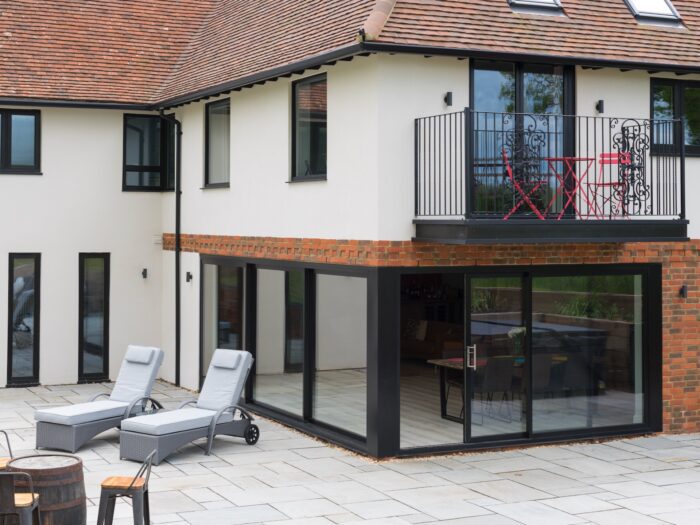
The best indicator of thermal efficiency is a door’s U value, and specifically the Uw value, which measures the whole window (glass and frame).
Victoria explains, “Essentially, the lower the number, the more thermally efficient it is. Our new Soho bi-fold external door can achieve Uw values as low as 0.8W/m 2 K, and our OS-29 sliding door goes as low as 1.3 W/m 2 K. Both already exceed the new building regulations that are due to come in next year.”
Bea advises that you ideally want your architect or designer to work together with your supplier to check the U values of the frame, the glass, and the junction details where the window frame meets the wall, so that the design and install does as much as possible to prevent any condensation.
2. Frame materials
“Timber frames will provide you with a more authentic look and work well for traditional period properties as they’re in-keeping with the property’s look and feel,” says Ryan.
“They’re also environmentally sustainable, extremely strong and durable, and the paint/stain finishes should also last a minimum of 5-10 years. However, over time a fresh application of treatment and painting will be required to maintain a ‘new’ appearance. We recommend opting for a strong hardwood for enhanced durability.”
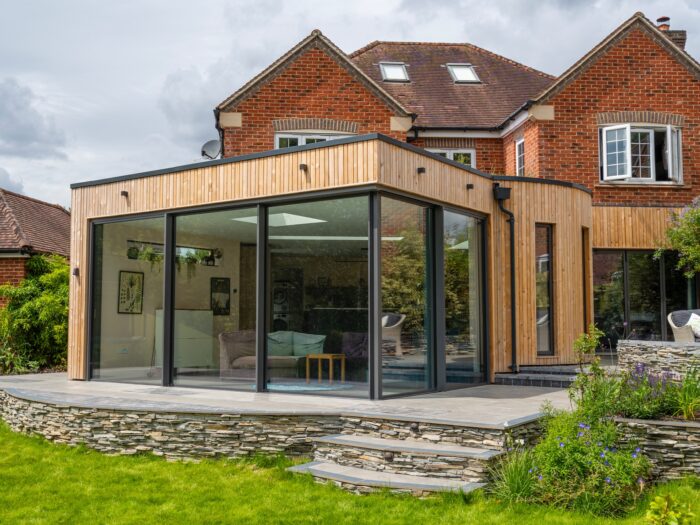
Another benefit of timber is its thermal efficiency.
“Timber is generally the best insulator but some modern aluminium frames can offer superb thermal efficiency to help combat heat loss and condensation issues,” Ryan adds.
“Aluminium frames are one of the most popular choices for homeowners seeking an on-trend industrial look. Lightweight and robust, aluminium frames are generally slimmer, which maximises the glass area, allowing more natural light into your home and are an excellent choice for energy-efficient contemporary homes.
“uPVC frames are low maintenance and non-corrosive and are a great affordable option, they’re available in a variety of colour choices to suit a wide range of property types. However, they usually have thicker frames and are less suitable for larger openings.”
If you’re after glass panels with minimal frames, then this material probably isn’t quite the right choice.
3. Guarantees
Typically, guarantees on sliding and bi-fold doors are similar, but in either case, you should check carefully to see what’s actually covered in the terms of the warranty.
“Some companies will boast a 20 or a 10 year guarantee, but this doesn’t usually cover the installation,” says Steve.
“Firms may only give a warranty of 12 months on moving parts for something that they install. It is always better to obtain a comprehensive guarantee from the manufacturer and installer, as this will alleviate any grey areas should an issue arise.”
4. Planning permission
Typically, you won’t require planning permission to install bi-fold or sliding doors in an existing property – though you should always check before beginning the work, particularly if you live in a period home or a new development that may have stricter planning covenants.
“However, if you are adjusting an opening to make it wider, or putting a new opening in to an existing wall, then you will need building regulations consent,” says Ryan.
“This will require structural calculations, so it’s always advisable to seek the advice of a professional, whatever your property type. If you’re looking to add bi-fold or sliding doors to a listed property, you’ll need to get planning permission. Even if your listed property already has existing sliding or bi-fold doors, you’ll still need to get fresh planning permission to approve the material, style and dimensions for any new frames.”
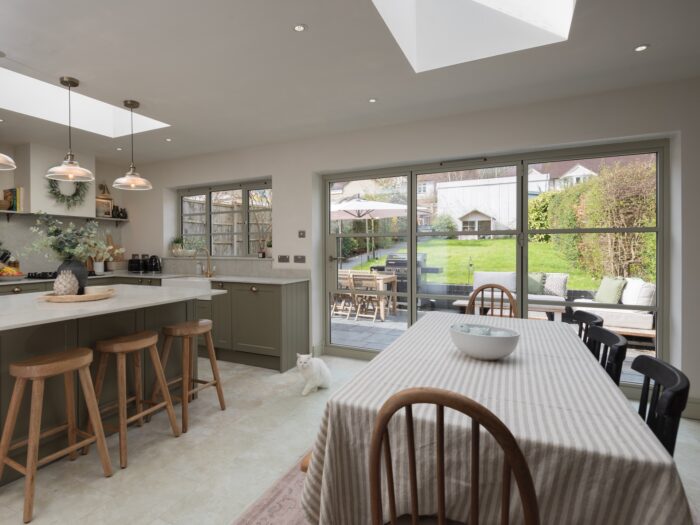
With any older home, listed or otherwise, if you want your bi-fold or sliding doors to blend in with a period style and character features, it’s important that you chose the same material, colour and design the work with the overall look of your property.
For a more authentic look, opt for timber bi-fold doors. These can be customised with glazing bars or astragal Georgian bars.
Another feature to consider are fixed top light or fan light windows, which can be added above the doors and can be designed to match the original decorative window features and the look of the property.
5. Security
“With most burglars entering a house from the side or back doors, security should also be a key
consideration for both sliding and bi-fold doors,” says Victoria.
“Look for accreditations as an indication of a product’s security standards, such as multi-point locking systems and a 3-Star British Standard kitemarked locking barrel. These will ensure homes remain safe and secure.”
How to choose window treatments for bi-fold and sliding doors
Debbie Leigh, design manager at ILIV, explains that special considerations need to be given when choosing window treatments for bi-fold and sliding doors.
“These types of doors are often chosen for their amazing outdoor views and the huge amount of
natural light they let in,” says Debbie.
“When considering window dressings, it’s therefore important to keep in mind the desire to maintain both these aspects, as they are integral to the appeal of these doors.”
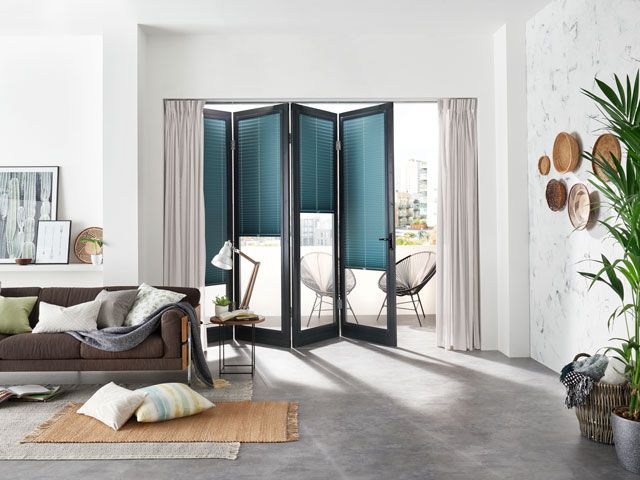
“Something else to consider is the height and size of the doors. Many bi-folds are built to be as large as possible and therefore, there may not be enough space between the ceiling and the top of the doors for a curtain pole,” Debbie adds.
“In the case of bi-folds, you will also need to think about whether the bi-folds open inwards or outwards, to ensure the window dressings don’t interfere with the opening and closing. Lastly, bi-folds – and sometimes sliding doors – often feature three or four panels, making them extremely wide. If you are considering curtains, a heavy-weight fabric is likely to droop under the sheer weight, which will not only spoil the overall look but will also make it very hard to pattern match.”
What are the best window treatments for bi-fold doors and why?
“Curtains with tie-backs, roller blinds and vertical blinds are all good options,” says Debbie.
“If opting for curtains I would steer away from heavier fabrics and instead consider voiles as they are lightweight and still allow a good amount of light in. Using tie-backs will ensure they are not damaged in the wind when the doors are open and are kept safely out of the way. I’d also recommend wave headers to make the most of the height of the room and also to give a modern feel, whilst keeping the curtains away from the door openings.”
What are the best window treatments for sliding doors and why?
“For sliding doors, I’d recommend sheer curtains, vertical blinds and sliding panel blinds,” says Debbie.
Sheer curtains add softness and elegance to sliding doors while still allowing natural light to filter through.
“They also offer a level of privacy without completely blocking the view, maintaining a connection with the outdoors,” Debbie adds.




